The stereotypical high school weight room across the country will consist of very similar styles of training. The “one-size-fits-all” methodology. Whatever that specific coach is specifically interested in doing in training will be the template used for every athlete that crosses the threshold of the weight room regardless of season, sport, or development level. The same exercises, at the same rep ranges, at the same intensities will be used regardless of specific needs that must be met per athlete. This style of training is certainly effective. An athlete could still grow, stay healthy, and be a better-rounded competitor through this style of training. However, because there is no real specialization given to their current season or development level, much of their success and resulting accomplishments will be limited.
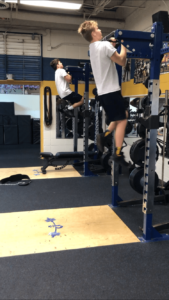
At St. Pius X we choose to do things a little differently. While we do believe there are necessary movements that must be completed for the ultimate growth and development of our athletes, how and when those exercises are implemented will differ greatly depending on the athlete. We believe that to consistently seek improvement in the strength and conditioning of our athletes, specific periodization must be considered in their training. Movement selection, repetition count, intensity, volume, and overall load must be considered largely on seasonal training basis. However, because most of our athletes play multiple sports, St. Pius X does not have the luxury of a true in-season, off-season, and pre-season periodized macro cycle. This is simply not a reality for most of our athletes because they move from being in-season in one sport to in-season in the next. We believe this to be a great thing. Athletes involved in multiple sports throughout their middle and high school careers prove to be better athletes overall but also tend to be healthier and less injury prone. Since this is the case, we have no choice but to train athletes with specific seasons in mind and find ways to continually get stronger, faster, and see continual progress even when in season. To allow an athlete to not train for a season will ultimately lead to decline in their strength, speed, and athletic development near the end of their season. This would lead to athletes who are getting worse athletically at the very moment in time when they should be ready to perform at their highest level. What’s more, in an environment like St. Pius X, this would lead to continual under-development of our athletes as they move from season to season.
Therefore, with these specific considerations and circumstances in mind, we break our athletes into six different categories depending on development level and seasonal training.
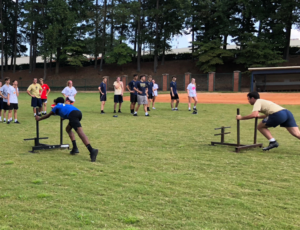
1- The Off-Season Athlete: This is the phase of training when an athlete will back off all of the extra, high skilled, sports specific work in order to increase their overall strength and conditioning as they develop a good base for the in-season sport, specific movements that come as they develop a good base for the in-season sport, specific movements that come later. This phase is absolutely necessary for the overall health of an athlete as it allows them to be better-rounded, balanced, and healthy heading into the rigors of their sport season. Many of our athletes will never find themselves in this category though we encourage and emphasize this specific phase of training as necessary for any sort of long-term athletic development. It is important to play multiple sports and be well-rounded in their athletic development. However, it is also critical to give your body rest and allow for rebuilding and strength gain in many of the areas that have been overlooked while in season. During off-season training, our primary focus will be on gaining strength, range of motion, and re-teaching the body how to handle workloads.
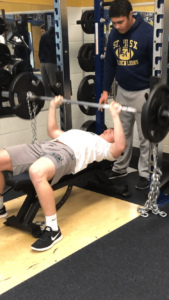
The absolute strength phase of their training is designed to build upon the preparatory work they’ve done in the first phase and give an athlete a leg up in prep for the upcoming season. The stimulus and taxation required to complete true, productive strength gain is immense. For this reason, much of it cannot be done during season when practices and competitions are taking their toll on an athlete’s body. The psyche, energy level, and physiological stability of an athlete does not allow for absolute strength work to be completed during season when sport specific volume is at its highest.
2- Preseason: Here at St. Pius X we firmly believe in training through the season. We never want to stop our training because the season has started. In this phase, the athlete is focused on maximal strength and exhibition of the growth they saw in their absolute strength phase.
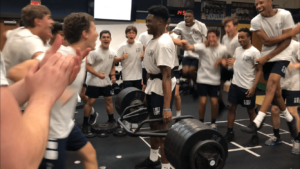
Their “pre-season” will be short because it is critical to get athletes moving towards their peak sooner and ready for live competition. Essentially, the athlete will gain as much true strength as possible while limiting the number of exercises in this phase in order to create a “reservoir of strength” to help them last the length of their season. This will include some work to exhaustion and will push the athlete physiologically in a much different way than absolute strength. This piece is basically the early phases of In-Season training. The start and stop date for this phase is largely dependent on the length and competition frequency of a sport. Sports that consume three months of competition season while competing two the three times a week will have an extended version of this phase of training in order to help the athlete survive the rigors and toll of their season without showing evidence of decline and under development. On the other hand, if the season only lasts ten weeks and competes once a week, the athlete will have limited time spent in this phase. We do this during this time of the season because if it is done early in the season the ripple effects will help an athlete peak at just the right time at the end of their season and allow them to remain healthy throughout the breadth of their competition time. This phase is critical because without it athletes get worse, slower, and weaker throughout the season and by the end of their season are far less developed and under-trained than they were at the beginning. Exercise selection however is critical in this phase of training. For athletes at the beginning of their season, exercises will be selected that are necessary for their overall athletic development and exercises will be excluded that take away from their performance in practice and competition.
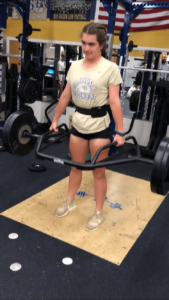
3- Sub-Varsity: Any athlete who is not competing at the varsity level on a regular and consistent basis will be put into this category. This category of athlete will typically be reserved for middle school and early high school aged athletes. During this phase of training these athletes will specifically focus on moving their body within space, perfection and precision of movement, and size and strength gains. Our goal will be to get them moving as perfectly as possible, create and strengthen structural support around their joints and introduce them to the types of movements that they will begin to build a foundation upon. The necessary adaptation work and hypertrophy work will be built into their training here. This stage is critical because without this preparatory work an athlete will be susceptible to injury and could waste their potential when they’re needed most at the varsity level.
4- Mid-Season: This phase of training occurs when an athlete is that their greatest volume in competition. This type of training is designed to move from maximal strength gain to exhibition of strength through power endurance. Exercise selection during this phase will become more and more sport and skilled specific and while the intensity will be relatively high, the rest intervals will increase as well. This phase of training is designed to help an athlete utilize the strength they’ve gained over the last couple phases of training while also preventing any unnecessary loading. Depending on the frequency of competition, many of the training sessions will train on competition day with specific parameters around their position or skill requirements in competition. This phase of training is a great way to allow athletes to continually exhibit their strength, while preventing any loss of strength and at the same time allowing them to grow in their application of strength through power and speed work.
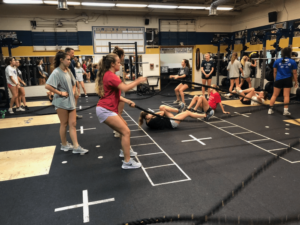
5- Late-Season Training: This phase is designed to be completed when athletes should be performing at their highest level, when most of their energy and effort is being expended in practice and competition. During this phase of training, their work in the weight room will focused solely on application of power, keeping ranges of motion, and making the body move through space to help gear and fuel their bodies for competition. Exercise selection and reps and percentages become more selective to help the athlete be ready for their competition. Furthermore, very specific sport-related auxiliary exercises will be intertwined into their training as well as a higher dosage of recovery methods in order to sustain an athlete for the remainder of their season and allow them to utilize their athleticism on their field of play. Their time in the weight room will be best spent maintaining their health, growing only in their application of power, and aiding in recovery. We are able to decrease their volume in training only because of the preparatory work done in the previous listed phases.
6- Post-Season Training: This phase is designed to help the athlete coming out of their respective sport season a chance to recover from the rigors of their season as well start to integrate back into the Off-Season phase. The focus is switched back to the development of movement to help the athlete prepare to train for absolute strength. The stresses of the season tend to put the athlete in only a very few select positions. With this in mind we will begin to put the athlete in ranges and positions designed to help with flexibility to gain motion to help gain the most strength possible through all ranges of motion. For the multi-sport athlete this phase of training will serve as a perfect “deload” to their psychological and physiological stress experienced in the weight room. This further allows them to jump into off-season training with renewed vigor with little to no downtime when their season is complete.
Multi-sport training and seasonal programming must be considered when training high school athletes to perform to the best of their potential. To assume all athletes are the same is lazy, short-sighted and a complete disregard for the uniqueness of the human body. Every student athlete has their own unique attributes that makes them great at what they do. The St. Pius X Strength and Conditioning department takes these truths into account when preparing our athletes to perform on their fields of choice.
In collaboration with Stan Luttrell, Head Strength and Conditioning Coach at Habersham Central and Spencer Arnold, Head Strength and Conditioning Coach at King’s Ridge Christian High School.
